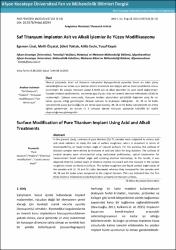| dc.contributor.author | Ünal, Egemen | |
| dc.contributor.author | Özçatal, Melih | |
| dc.contributor.author | Taktak, Şükrü | |
| dc.contributor.author | Evcin, Atilla | |
| dc.contributor.author | Kayalı, Yusuf | |
| dc.date.accessioned | 2016-01-25T07:00:16Z | |
| dc.date.available | 2016-01-25T07:00:16Z | |
| dc.date.issued | 2015 | |
| dc.identifier.issn | 2149-3367 | |
| dc.identifier.uri | http://hdl.handle.net/11630/4208 | |
| dc.description.abstract | Mevcut çalışmada, ticari saf titanyum numuneler biyouyumluluk açısından önem arz eden yüzey
pürüzlülüğünün sıvı temas açısı üzerine etkisini incelemek için değişik asit ve alkali çözeltilerine maruz
bırakılmıştır. Bu amaçla, titanyum yüzeyi 6 farklı asit ve alkali çözeltileri ile uzun süreli dağlanmıştır.
Yüzeyler mekanik profilometre, sıvı temas açısı ölçüm cihazı ve taramalı elektron mikroskobu (SEM) ile
incelenmiştir. Çalışma sonucunda, titanyum implant yüzeyindeki pürüzlülük değerinin artışı ile sıvı
temas açısının arttığı görülmüştür. Orijinal numune ile mukayese edildiğinde, 1K, 2K ve 3K kodlu
numunelerde yüzey pürüzlülüğü ve sıvı temas açısı düşmüş, 4K, 5K ve 6K kodlu numunelerde ise artma
eğilimi göstermiştir. Bu durum ilk 3 kimyasal işlemin titanyum yüzeyinde hidrofilik bir özellik
oluşturduğunun göstergesidir. | en_US |
| dc.description.abstract | In the present study, commercial pure titanium (Cp-Ti) samples were subjected to various acid
and alkali solutions to study the role of surface roughness, which is important in terms of
biocompatibility, on liquid contact angle of implant surfaces. For this purpose, the surfaces of
titanium samples were etched by mixtures of acid and alkali for long duration. The surfaces of
treated samples were characterized using mechanical profilometer, optical tensiometer for
measurement liquid contact angle and scanning electron microscopy. In the results, it was
observed that the contact angle of titanium implant increased with the increase in the surface
roughness values on titanium surfaces. The surface roughness and liquid contact angle values of
the samples with 1K, 2K and 3K codes decreased, whereas they increased for the samples with
4K, 5K and 6K codes when compared to the original titanium. This case indicated that the first
three chemical treatments created hydrophilic property on titanium surfaces. | en_US |
| dc.language.iso | tur | en_US |
| dc.publisher | Afyon Kocatepe Üniversitesi | en_US |
| dc.rights | info:eu-repo/semantics/openAccess | en_US |
| dc.subject | Saf titanyum | en_US |
| dc.subject | İmplant | en_US |
| dc.subject | Kimyasal modifikasyon | en_US |
| dc.subject | Sıvı temas açısı | en_US |
| dc.title | Saf titanyum implantın asit ve alkali İşlemler ile yüzey modifikasyonu | en_US |
| dc.title.alternative | Surface modification of pure titanium implant using acid and alkali treatments | en_US |
| dc.type | article | en_US |
| dc.relation.journal | Afyon Kocatepe Üniversitesi, Fen ve Mühendislik Bilimleri Dergisi | en_US |
| dc.department | Afyon Kocatepe Üniversitesi, Teknoloji Fakültesi, Metalurji ve Malzeme Mühendisliği Bölümü | en_US |
| dc.identifier.volume | 15 | en_US |
| dc.identifier.startpage | 6 | en_US |
| dc.identifier.endpage | 13 | en_US |
| dc.identifier.issue | 3 | en_US |
| dc.relation.publicationcategory | Makale - Ulusal Hakemli Dergi - Kurum Yayını | en_US |



















